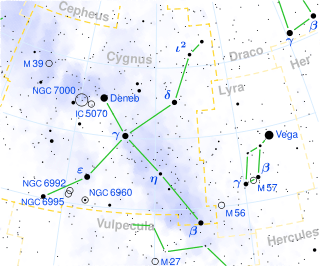Sigma Cygni
Sigma Cygni, Latinised from σ Cygni, is a blue supergiant star in the constellation Cygnus. Its apparent magnitude is 4.2. It belongs to the Cygnus OB4 stellar association and is located approximately 3,300 light years away from Earth.
 | |
| Observation data Epoch J2000 Equinox J2000 | |
|---|---|
| Constellation | Cygnus |
| Right ascension | 21h 17m 24.95244s[1] |
| Declination | +39° 23′ 40.8528″[1] |
| Apparent magnitude (V) | 4.233[2] |
| Characteristics | |
| Spectral type | B9 Iab[2] |
| U−B color index | −0.386[2] |
| B−V color index | +0.123[2] |
| Astrometry | |
| Radial velocity (Rv) | −5.30 ± 0.40[3] km/s |
| Proper motion (μ) | RA: −0.13[1] mas/yr Dec.: −3.58[1] mas/yr |
| Parallax (π) | 1.13 ± 0.19[1] mas |
| Distance | 1,000[4] pc |
| Absolute magnitude (MV) | −6.18[4] |
| Details | |
| Mass | 15[5] M☉ |
| Radius | 54[4] R☉ |
| Luminosity | 52,500[6] L☉ |
| Surface gravity (log g) | 1.85[2] cgs |
| Temperature | 10.800[2] K |
| Metallicity | 0.0[6] |
| Rotational velocity (v sin i) | 14[2] km/s |
| Age | 16[6] Myr |
| Other designations | |
| Database references | |
| SIMBAD | data |
Because of its location at the galactic disk, σ Cyg is obstructed by interstellar dust and is reddened by around 0.2 magnitudes and loses about 0.6 magnitudes at visual wavelengths.[2] Allowing for this, the star is over 50,000 times as luminous as the sun.
Spectral analysis of the star showed that photospheric SiII and HeI lines display a simultaneous, periodic variability. The periodicity was calculated at 1.59 hours in all three lines and it might be the result of stellar oscillations.[7] No clear variation in the brightness has been detected.[8]
References
- Van Leeuwen, F. (2007). "Validation of the new Hipparcos reduction". Astronomy and Astrophysics. 474 (2): 653. arXiv:0708.1752. Bibcode:2007A&A...474..653V. doi:10.1051/0004-6361:20078357.
- Firnstein, M.; Przybilla, N. (2012). "Quantitative spectroscopy of Galactic BA-type supergiants. I. Atmospheric parameters". Astronomy & Astrophysics. 543: A80. arXiv:1207.0308. Bibcode:2012A&A...543A..80F. doi:10.1051/0004-6361/201219034.
- Gontcharov, G. A. (2006). "Pulkovo Compilation of Radial Velocities for 35 495 Hipparcos stars in a common system". Astronomy Letters. 32 (11): 759. arXiv:1606.08053. Bibcode:2006AstL...32..759G. doi:10.1134/S1063773706110065.
- Markova, N.; Puls, J. (2008). "Bright OB stars in the Galaxy. IV. Stellar and wind parameters of early to late B supergiants". Astronomy and Astrophysics. 478 (3): 823. arXiv:0711.1110. Bibcode:2008A&A...478..823M. doi:10.1051/0004-6361:20077919.
- Przybilla, N.; Firnstein, M.; Nieva, M. F.; Meynet, G.; Maeder, A. (2010). "Mixing of CNO-cycled matter in massive stars". Astronomy and Astrophysics. 517: A38. arXiv:1005.2278. Bibcode:2010A&A...517A..38P. doi:10.1051/0004-6361/201014164.
- Tanrıverdi, Taner (2013). "Elemental abundances of the supergiant stars σ Cygnus and η Leonis". New Astronomy. 25: 50. arXiv:1512.04557. Bibcode:2013NewA...25...50T. doi:10.1016/j.newast.2013.03.013.
- Kraus, M.; Tomić, S.; Oksala, M. E.; Smole, M. (June 2012). "Detection of a 1.59 h period in the B supergiant star HD 202850". Astronomy and Astrophysics. 542: L32. arXiv:1205.5391. Bibcode:2012A&A...542L..32K. doi:10.1051/0004-6361/201219319.
- Koen, Chris; Eyer, Laurent (2002). "New periodic variables from the Hipparcos epoch photometry". Monthly Notices of the Royal Astronomical Society. 331: 45. arXiv:astro-ph/0112194. Bibcode:2002MNRAS.331...45K. doi:10.1046/j.1365-8711.2002.05150.x.